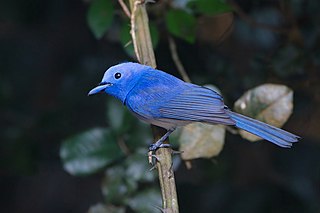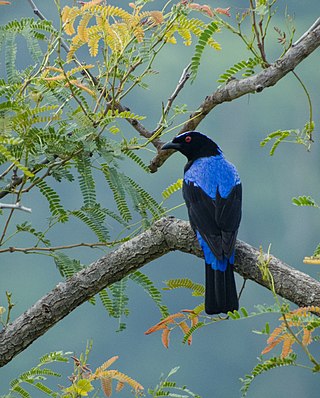
Tickell's blue flycatcher is a small passerine bird in the flycatcher family. This is an insectivorous species which breeds in tropical Asia, from the Indian Subcontinent eastwards to Bangladesh and western Myanmar. The Indochinese blue flycatcher was formerly considered conspecific. They are blue on the upperparts and the throat and breast are rufous. They are found in dense scrub to forest habitats. The name commemorates the wife of the British ornithologist Samuel Tickell who collected in India and Burma.

The black-naped monarch or black-naped blue flycatcher is a slim and agile passerine bird belonging to the family of monarch flycatchers found in southern and south-eastern Asia. They are sexually dimorphic, with the male having a distinctive black patch on the back of the head and a narrow black half collar ("necklace"), while the female is duller with olive brown wings and lacking the black markings on the head. They have a call that is similar to that of the Asian paradise flycatcher, and in tropical forest habitats, pairs may join mixed-species foraging flocks. Populations differ slightly in plumage colour and sizes.

The Asian fairy-bluebird is a medium-sized, arboreal passerine bird. This fairy-bluebird is found in forests across tropical southern Asia, Indochina and the Greater Sundas. Two or three eggs are laid in a small cup nest in a tree. It was described by British ornithologist John Latham in 1790. The only other member of the genus and family is the Philippine fairy-bluebird, I. cyanogastra, which replaces the Asian fairy-bluebird in most of the Philippines. Both species are considered as sacred to the Tagalog people as they are perceived as tigmamanukan omens.

The pin-striped tit-babbler, also known as the yellow-breasted babbler, is a species of bird in the Old World babbler family Timaliidae that is found in South and Southeast Asia.

The blue-eared kingfisher is found in Asia, ranging across the Indian subcontinent and Southeast Asia. It is found mainly in dense shaded forests where it hunts in small streams. It is darker crowned, with darker rufous underparts and lacking the rufous ear stripe of the common kingfisher which is found in more open habitats. A number of subspecies have been described that differ in measurement and colour shade. Adult males have an all dark bill while females have a reddish lower mandible.

Rück's blue flycatcher is a passerine bird in the Old World flycatcher family Muscicapidae. It is known from only four specimens and is endemic to a small area in northeast Sumatra, Indonesia, inhabiting primary lowland forest. Although all specimens share common characteristics, such as a black bill, brown iris, and black feet, two of the collected specimens show some physical discrepancy with the other two. They were initially described as Cyornis vanheysti before being accepted as specimens of C. ruckii. Rück's blue flycatcher has also been compared to other species of Cyornis.

The black paradise flycatcher, also known as the Japanese paradise flycatcher, is a medium-sized passerine bird native to southeastern Asia. It is a glossy black, chestnut and white bird, slightly smaller than either the Amur paradise flycatcher or Blyth's paradise flycatcher, but similar in appearance. Males have exceptionally long tails. Females are generally duller in appearance and have shorter tails.

The ruby-cheeked sunbird is a species of sunbird in the family Nectariniidae.

Cyornis is a genus of birds in the Old World flycatcher family Muscicapidae most of which are native to Southeast Asia.

The hainan blue flycatcher is a bird in the family Muscicapidae. The species was first described by William Robert Ogilvie-Grant in 1900. It is found in Cambodia, China, Hong Kong, Laos, Myanmar, Thailand, and Vietnam. Its natural habitat is subtropical or tropical moist lowland forests.

The Malaysian blue flycatcher is a species of bird in the family Muscicapidae. It has a brilliant blue upperparts, a pale orange throat and chest, and a white belly. A slightly paler female has a whitish throat, while a male’s is blue; the sexes are otherwise quite similar.

The pale blue flycatcher is a bird in the family Muscicapidae. The species was first described by Edward Blyth in 1843.

The black-winged flycatcher-shrike is a species of bird in the flycatcher-shrike genus, Hemipus. It is usually placed in the Vangidae. It is found in the Malay Peninsula and the Greater Sunda Islands. Its natural habitats are lowland forests and sometimes swamps and mangroves. The International Union for Conservation of Nature (IUCN) has assessed it as being of least concern.

The blue whistling thrush is a bird in the Old World flycatchers family Muscicapidae that is found in the mountains of Central Asia, South Asia, China and Southeast Asia. It is known for its loud human-like whistling song at dawn and dusk. The widely distributed populations show variations in size and plumage with several of them considered as subspecies. Like others in the genus, they feed on the ground, often along streams and in damp places foraging for snails, crabs, fruits and insects.

The large niltava is a species of bird in the Old world flycatcher family Muscicapidae. It is found in Bangladesh, Bhutan, Cambodia, China, India, Indonesia, Laos, Malaysia, Myanmar, Nepal, Thailand and Vietnam. Its natural habitat is subtropical or tropical montane forests.

The grey-throated babbler is a species of passerine bird in the Old World babbler family Timaliidae.

The red-headed trogon is a species of bird in the family Trogonidae.

The Chinese blue flycatcher is a small passerine bird in the flycatcher family, Muscicapidae. The Chinese blue flycatcher is found in southern China and the Malay Peninsula. It previously was considered a subspecies of the blue-throated blue flycatcher.

Blyth's paradise flycatcher, also called the oriental paradise flycatcher, is a species of bird in the family Monarchidae. It is native from southern China to Sumatra and Melanesia. Formerly, it was considered a subspecies of the Asian paradise flycatcher until elevated to species rank by the IOC in 2015.




















